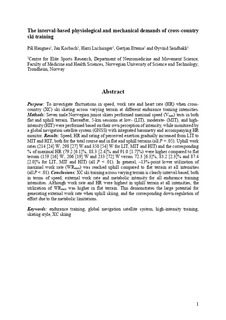| dc.description.abstract | PURPOSE: To investigate fluctuations in speed, work rate and heart rate (HR) when cross-country (XC) ski skating across varying terrain at different endurance training intensities. METHODS: Seven male Norwegian junior skiers performed maximal speed (Vmax) tests in both flat and uphill terrain. Thereafter, 5-km sessions at low- (LIT), moderate- (MIT), and high-intensity (HIT) were performed based on their own perception of intensity, while monitored by a global navigation satellite system (GNSS) with integrated barometry and accompanying HR monitor. RESULTS: Speed, HR and rating of perceived exertion gradually increased from LIT to MIT and HIT, both for the total course and in flat and uphill terrains (all P<0.05). Uphill work rates (214[24]W, 298[27]W and 350[54]W for LIT, MIT and HIT) and the corresponding % of maximal HR (79.2 [6.1]%, 88.3[2.4]% and 91.0[1.7]%) were higher compared to flat terrain (159[16]W, 206[19]W and 233[72]W versus 72.3[6.3]%, 83.2[2.3]% and 87.4[2.0]% for LIT, MIT and HIT) (all P<.01). In general, ~13%-point lower utilization of maximal work rate (WRmax) was reached uphill compared to flat terrain at all intensities (all P<.01). CONCLUSIONS: XC ski training across varying terrain is clearly interval-based, both in terms of speed, external work rate and metabolic intensity for all endurance training intensities. Although work rate and HR were highest in uphill terrain at all intensities, the utilization of WRmax was higher in flat terrain. This demonstrates the large potential for generating external work rate when uphill skiing, and the corresponding down-regulation of effort due to the metabolic limitations. KEYWORDS: Endurance training; XC skiing; global navigation satellite system; high-intensity training; skating style | nb_NO |
